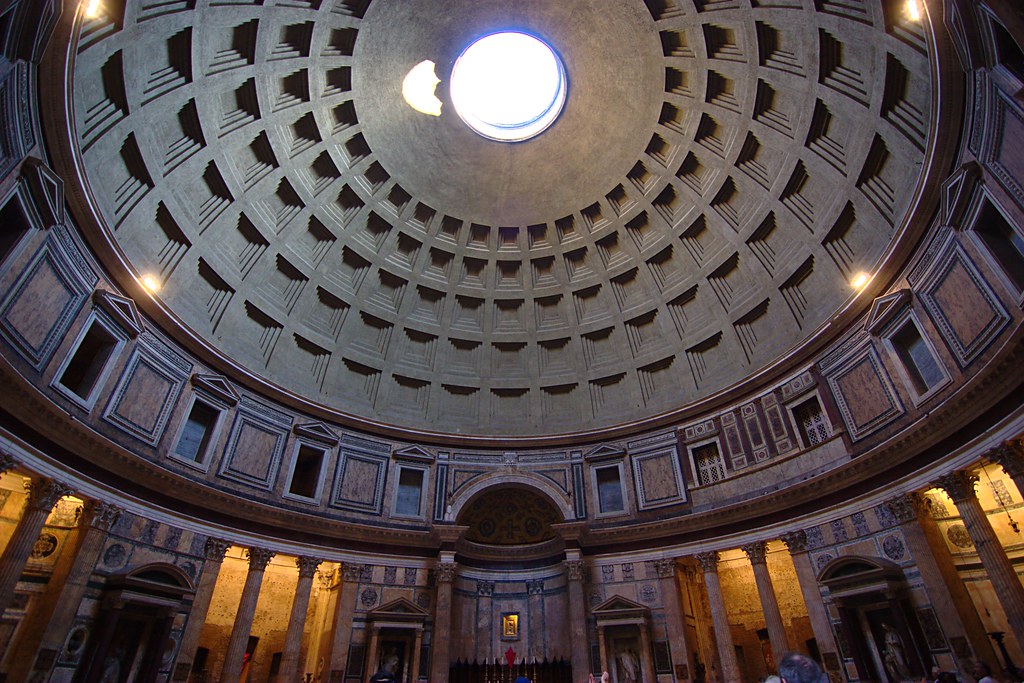Pantheon is a term derived from the ancient Greek world. It means: “honor all gods”. The pantheon was first built by Marcus Vipsanius Agrippa as a temple to all gods, during the reign of Augustus (27 BC – 14 AD).

Image source: https://search.creativecommons.org/photos/671d7525-11e6-4116-a6fe-2f9e3ecda601 by Roberta Dragan
Even now, nearly 2000 years after its construction, the pantheon is a remarkable building to see. The spectacular design, the proportions, the elegance, and the harmony are evocative reminders of the architecture of the great Roman Empire. When Michelangelo saw it for the first time he said that it looked more like the work of angels than humans.
The Pantheon is a former Roman temple, now a church, in Rome, Italy, on the site of an earlier temple commissioned by Marcus Agrippa during the reign of Augustus (27 BC – 14 AD).
Pantheon architecture
The Pantheon was built of two previous Pantheon buildings, one commissioned by Marcus Vipsanius Agrippa (27-25 BCE) and the second by Domitian. The first was destroyed following a fire in 80 CE and the second was struck by lightning in 110 CE and again burned. Probably, the third Pantheon was begun during the reign of Trajan (98-117 CE) but was not finished until 125 CE, when Hadrian was emperor, and in which he often summoned the Roman Senate. This is the version still present in the center of Rome.

Image source: https://search.creativecommons.org/photos/8b6676cc-d385-422d-a4e2-de06bb021941 by Mustang Joe
The building is circular with a portico of large Corinthian granite columns (eight in the first order and two groups of four behind) under a pediment. A rectangular vestibule connects the portico to the rotunda, located under a coffered concrete dome, with a central opening (oculus) towards the sky. Almost two thousand years later the dome of the Pantheon is still the largest reinforced concrete dome in the world. The height of the oculus and the diameter of the inner circle are the same, 142 feet (43 m).

Image source: https://search.creativecommons.org/photos/dc22440f-6e8d-4fff-b0d8-d85c5ed5ac9f by Biker Jun
It is one of the best-preserved Roman buildings, also due to its continuous use throughout its history, and since the 7th century, the Pantheon has been used as a church dedicated to “St. Mary and the Martyrs”, known as “Santa Maria Rotonda”. The square in front of the Pantheon is called Piazza della Rotonda.
The large circular domed cell of the Pantheon, with a conventional temple portico facade, was unique in Roman architecture. However, it became standard when the classical styles were revived.

Image source: https://search.creativecommons.org/photos/598eb5bc-6f0b-4f74-bbb3-21d4cf638c79 by stanrandom
Pantheon’s mistery
The Pantheon’s original use is unknown, except that it was classified as a temple. However, no cult is known therefore the Pantheon may have been designed as a place where the emperor could make public appearances in an environment that reminded him of his divine status, equal to the other gods of the Roman pantheon and his predecessor deified emperors. It is not known how people worshipped in the building, as the structure of the temple is different from that of other traditional Roman temples such as in the Roman Forum. The Pantheon exists today in a surprising form because the Byzantine emperor Phocas gave it to Pope Boniface IV in A.D 608 and since then it has been used as a church. The Pantheon has been in use since its construction.

Image source: https://commons.wikimedia.org/wiki/File:Giovanni_Paolo_Panini_-_Interior_of_the_Pantheon,_Rome_-_Google_Art_Project.jpg
Info source:
https://www.rome.info/pantheon/
http://romeonsegway.com/10-facts-about-the-pantheon/
